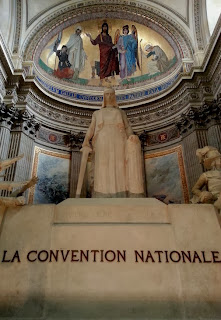The Pantheon was originally built as a church dedicated
to Saint Genevieve and to house the reliquary chasse containing her relics but,
and after many changes, it now functions as a secular mausoleum containing the
remains of distinguished French citizens.
The building's history dates back to King
Louis XV, who vowed in 1744 that if
he recovered from his illness he would replace the ruined church of the Abbey
of St Genevieve with an edifice worthy of the patron saint of Paris. He did
recover, and in 1757 construction began on the re-building of the old church. The
remodelled Abbey of St. Genevieve was finally completed in 1790 - coinciding with the early stages of the
French Revolution.
One year later the National Constituent Assembly ordered that the building be changed from a church to a mausoleum for the interment of great Frenchmen.
When its life was that of a Christian church, the outside walls of this great temple featured large windows - some of which were lead-lighted - however when its use changed to that of a mausoleum, the windows were bricked in and large painted canvasses fixed to the walls.
The patriotic - and semi-religious - themes painted on the canvasses depict the glories of the French people.
The patriotic - and semi-religious - themes painted on the canvasses depict the glories of the French people.
The inscription above the entrance reads AUX GRANDS
HOMMES LA PATRIE RECONNAISSANTE ( "To
the great men, the grateful homeland" ). Interment here is severely
restricted and is allowed only by a parliamentary act for "National
Heroes".
Leaving the gloriously decorative main body of the
building you descend down a very narrow spiral staircase into the more sombre
crypt where a central passage runs the length of the building with smaller
passages running off to each side, and then off those passages are dozens of
rooms containing the bodies of the famous who are interred here – including Voltaire,
Rousseau, Victor Hugo, Alexandre Dumas, Émile Zola, Jean Moulin, Marie Curie, Louis Braille, Jean
Jaurès.
In January 2007, President Jacques Chirac unveiled a
plaque in the Panthéon to more than 2600 people recognized as Righteous Among the Nations by the Yad
Vashem memorial in Israel for saving the lives of Jews who would otherwise have
been deported by the Nazis to concentration camps.
Looking back towards the Eiffel Tower
Visiting the Pantheon was a very moving experience – apart from the beauty and the grandeur of the building upstairs, knowing that down in the crypt lay the remains of hundreds who have influenced the direction of this nation.

























No comments:
Post a Comment
Note: Only a member of this blog may post a comment.